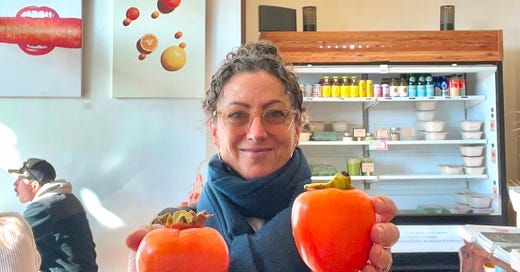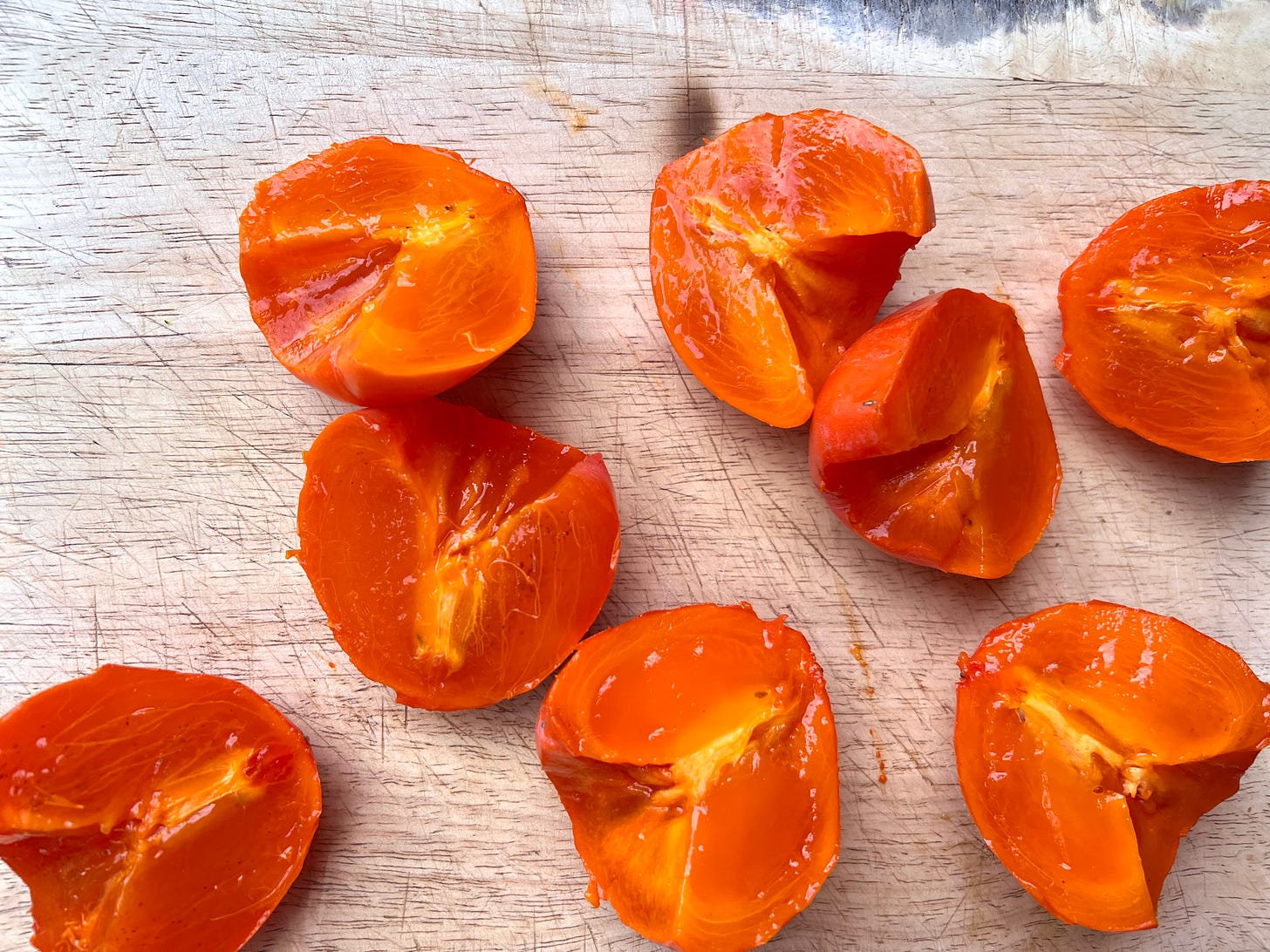It’s late Fall, barrelling toward the Winter Solstice, and hanging from so many trees in my part of the world are hundreds of jewel-toned orbs that no one will pick. A stunning sight to behold: The trees without their leaves, loaded with just the glorious globes of bright orange fruits on the burnished branches, more beautiful than at any other time of year. Apparently this beauty is not tantalizing enough for most of us to want the fruit. Gasp! Luckier for me then, as everyone offers up their trees for my personal gleaning. I hoover them up, regardless of variety, regardless of having to climb ladders in the cold to gather them. Free fruit? I’ll take it!
There are many varieties of persimmon, but two dominate: Fuyu and Hachiya. Don’t know which are which? Here’s a little something to help you remember: Fuyu are flat and Hachiya are heart-shaped. Maybe alliteration doesn’t help you like it does me? Still, bet you won’t forget this for the rest of your life!
At my restaurant, Lunchette, we always serve the Fuyu variety raw, in salads or sides, where the crispy, umami-sweet flesh adds crunch and a bit of je ne c’est quoi, and the Hachiya we, well, read below.
Fuyu (flat):
My family eats Fuyu like apples, but I think mixed in with other seasonal vegetables, they’re even better. This month our seasonal salad includes local lettuces and chicories, lentils, shaved fennel, watermelon radish, pickled onions, toasted sunflower seeds, Fuyu persimmons, and a dill-Green Goddess dressing. It’s sublime, full of crunchy, earthy, tart, sweet, and creamy tastes and textures. We’ve also used them to both add to and enhance our baked ricotta, along with sunflower sprouts, pickled fennel, and radish as a side (drizzled with a pistachio-salsa verde to bring the whole dish together.) While rich in flavor, the persimmons still tend to cut the fat of the ricotta.
Hachiya (heart-shaped):
These are the more prolific and least enjoyed variety, by most accounts. They are harder to work with than their easy-to-eat Fuyu cousins. You actually need to have some patience with them. We allow them to ripen until their insides are quite literally like jelly (see the pic.) Only then are they ready. One day too early, the astringency will leave your mouth puckered up for 24 years. Ok, an exaggeration, but it’s beyond bitter or tannic. It’s downright ruinous. Thus, we wait and wait until the consistency is jelly-like perfection, and then, only then, do we play with them.
Come late Fall, we always make Hachiya persimmon jam to top our Golden Milk chia puddings at the restaurant. And for Christmas dinner with the family, it’s hard to not make persimmon pudding cakes. Everyone loves them in our family. I’ve always used Chez Panisse’s recipe as a base but I’ve certainly tweaked it over the years. You can too if you are a collector of old cookbooks and happen to have this one.. If not, search online for David Lebovitz recipes for his. His recipes always work.
As promised:
Persimmon Jam
y = 1 quart
10 ripe Hachiya
⅓ cup sugar
Zest and flesh of one orange (after zesting, cut all the pith away, dice, removing any seeds)
Zest and juice of 2 lemons (same as above)
¼ tspn salt
1 cinnamon stick
Directions:
Rinse and dry the fruit. Slice open and squeeze the pulp into a medium heavy bottomed saucepan. Add all else and cook on high heat until rolling boil (stirring occasionally). Reduce heat to medium-low and cook for 45 minutes. Blend in a blender or with a Burr mixer. If you’re canning, follow the directions on your canner. Otherwise, place into jars to use and give as gifts. This freezes excellently.
P.S. If you want the recipe for the dill-Green Goddess referenced in the Fall salad, leave a comment and I’ll happily oblige. It is easy, delicious, avocado based, and heart healthy.
P.S.S. If you’re reading this and have trees for me to glean, and you live in or near Petaluma, CA, leave a comment. I promise you I’ll come by! Happily.







I want the green goddess recipe. Have too many avocados as 3 people in my family bought avocados on the same day.